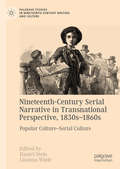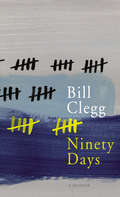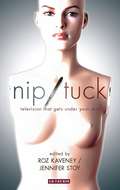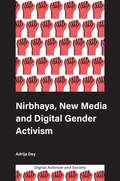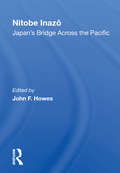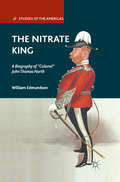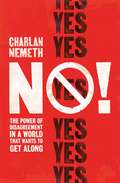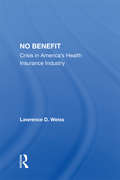- Table View
- List View
Nineteenth-Century Serial Narrative in Transnational Perspective, 1830s−1860s: Popular Culture—Serial Culture (Palgrave Studies in Nineteenth-Century Writing and Culture)
by Daniel Stein Lisanna WieleThis volume examines the emergence of modern popular culture between the 1830s and the 1860s, when popular storytelling meant serial storytelling and when new printing techniques and an expanding infrastructure brought serial entertainment to the masses. Analyzing fiction and non-fiction narratives from the United States, France, Great Britain, Germany, Austria, Turkey, and Brazil, Popular Culture—Serial Culture offers a transnational perspective on border-crossing serial genres from the roman feuilleton and the city mystery novel to abolitionist gift books and world’s fairs.
The Nineties: When Surface Was Depth
by Michael Bracewellthe first clear anatomy of a confused decade, the 1990s – ‘Bracewell, with great verve and style, animates the cultural conversation’, Greil Marcus
Ninety Days: A Memoir Of Recovery
by Bill CleggThe goal is ninety: just ninety clean and sober days to loosen the hold of the addiction that caused Bill Clegg to lose everything. With seventy-three days in rehab behind him he returns to New York and attends two or three meetings each day. It is in these refuges that he befriends essential allies including the seemingly unshakably sober Asa, and Polly, who struggles daily with her own cycle of recovery and relapse. At first, the support is not enough: Clegg relapses for the first time with only three days left, turning his calendar back to day one. Written with uncompromised immediacy, Ninety Days begins where Portrait of an Addict as a Young Man ends - and tells the wrenching story of Bill Clegg's battle to reclaim his life. As any recovering addict knows, hitting rock bottom is just the beginning.
Ninigret, Sachem of the Niantics and Narragansetts: Diplomacy, War, and the Balance of Power in Seventeenth-Century New England and Indian Country
by Julie A. Fisher David J. SilvermanNinigret (c. 1600–1676) was a sachem of the Niantic and Narragansett Indians of what is now Rhode Island from the mid-1630s through the mid-1670s. For Ninigret and his contemporaries, Indian Country and New England were multipolar political worlds shaped by ever-shifting intertribal rivalries. In the first biography of Ninigret, Julie A. Fisher and David J. Silverman assert that he was the most influential Indian leader of his era in southern New England. As such, he was a key to the balance of power in both Indian-colonial and intertribal relations. Ninigret was at the center of almost every major development involving southern New England Indians between the Pequot War of 1636–37 and King Philip’s War of 1675–76. He led the Narragansetts’ campaign to become the region’s major power, including a decades-long war against the Mohegans led by Uncas, Ninigret’s archrival. To offset growing English power, Ninigret formed long-distance alliances with the powerful Mohawks of the Iroquois League and the Pocumtucks of the Connecticut River Valley. Over the course of Ninigret’s life, English officials repeatedly charged him with plotting to organize a coalition of tribes and even the Dutch to roll back English settlement. Ironically, though, Ninigret refused to take up arms against the English in King Philip’s War. Ninigret died at the end of the war, having guided his people through one of the most tumultuous chapters of the colonial era.
Nintendo: Playing with Power (Global Media Giants)
by Randy NicholsOriginally founded in 1889 as a manufacturer of playing cards, this book examines the history and political economic status of the multinational consumer electronics and video game giant Nintendo. This book offers a deeper examination into Nintendo as a global media giant, with some of the industry’s best-selling consoles and most recognizable intellectual property including Mario, Pokémon, and Zelda. Drawing upon the theory of the political economy of communication, which seeks to understand how communication and media serve as key mechanisms of economic and political power, Randy Nichols examines how Nintendo has maintained its dominance in the global video game industry and how it has used its position to shape that industry. This book argues that while the company’s key figures and main franchises are important, Nintendo’s impact as a company – and what we can learn from its evolution – is instructive beyond the video game industry. This book is perfect for students and scholars of media and cultural industries, critical political economy of media, production studies, and games studies.
Nintendo: Playing with Power (Global Media Giants)
by Randy NicholsOriginally founded in 1889 as a manufacturer of playing cards, this book examines the history and political economic status of the multinational consumer electronics and video game giant Nintendo. This book offers a deeper examination into Nintendo as a global media giant, with some of the industry’s best-selling consoles and most recognizable intellectual property including Mario, Pokémon, and Zelda. Drawing upon the theory of the political economy of communication, which seeks to understand how communication and media serve as key mechanisms of economic and political power, Randy Nichols examines how Nintendo has maintained its dominance in the global video game industry and how it has used its position to shape that industry. This book argues that while the company’s key figures and main franchises are important, Nintendo’s impact as a company – and what we can learn from its evolution – is instructive beyond the video game industry. This book is perfect for students and scholars of media and cultural industries, critical political economy of media, production studies, and games studies.
Ninth Art. Bande dessinée, Books and the Gentrification of Mass Culture, 1964-1975 (Palgrave Studies in Comics and Graphic Novels)
by Sylvain LesageIn France, comics are commonly referred to as the "ninth art". What does it mean to see comics as art? This book looks at the singular status of comics in the French cultural landscape. Bandes dessinées have long been published in French newspapers and magazines. In the early 1960s, a new standard format emerged: large hardback books, called albums. Albums played a key role in the emergence of the ninth art and its acceptance among other forms of literary narrative. From Barbarella in 1964 to La Ballade de la mer salée in 1975, from Astérix and its million copies to Tintin and its screen versions, within the space of just a few years the comics landscape underwent a deep transformation.The album opened up new ways of creating, distributing, and reading bandes dessinées. This shift upended the market, transformed readership, initiated new transmedia adaptations, generated critical discourse, and gave birth to new kinds of comics fandom. These transformations are analysed through a series of case studies, each focusing on a noteworthy album. By retracing the publishing and critical history of these classic bandes dessinées, this book questions the blind spots of a canon based on the album format and uncovers the legitimisation processes that turned bande dessinée into the ninth art.
Nip/Tuck: Television That Gets Under Your Skin (Reading Contemporary Television)
by Roz Kaveney Jennifer StoyPromoted as a 'disturbingly perfect' and 'deeply shallow' television drama and created by Ryan Murphy, who is also behind the teen musical show Glee, Nip/Tuck has been one of the most popular and controversial shows on cable TV. The misadventures and soap opera-esque entanglements of the lives of plastic surgeons Christian Troy (Julian McMahon) and Sean McNamara (Dylan Walsh) won Golden Globes and boycotts from the American Family Association. Yet, as this first full critical examination of Nip/Tuck shows, ironically the show is an examination of the American family and its many definitions, anxieties and complications of gender and sexuality, and the class issues and illusions surrounding the American dream. It is also revealed as a glorious televisual melodrama, full of Gothic tropes and contemporary sensationalism and at the same time, a deeply misanthropic satire on the American dream with a sometimes highly problematic portrayal of women and minorities. The book also features an interview with frequent Nip/Tuck director Elodie Keene and an episode guide.
The Nirankari Sikhs
by John C.B. WebsterThis is a new edition of Dr. Webster's, The Nirankari Sikhs (1979), which has been recognized as 'single most important work on the history of Baba Dayal and his successors'. It updates the earlier edition not only by dealing with the past forty years of Nirankari history but also by taking into account subsequent scholarship on the history of Sikhism, especially during the first half of the nineteenth century. Further, it also provides two additional primary sources of nineteenth century Nirankari history along with the nine included in the earlier edition.This new edition will be of value not only to those scholars interested in Nirankari history but also to those seeking a fuller understanding of the evolution of Sikh identity since the nineteenth century. Sikh identity has been a major issue for Nirankaris in recent decades because they have been confused with the Sant Nirankari Mandal which makes no claims to a Sikh identity. Nirankaris, like other Sikhs, base their beliefs and practices upon the Guru Granth Sahib and revere the ten Sikh gurus. For this reason they view themselves, and are considered by other Sikhs, to be minority group within Sikhism. They are distinguished from other Sikhs, most obviously in not fully embracing the Khalsa tradition of the Sikhs and in having a continuing hereditary line of human gurus. How such similarities and differences have affected their own, and the very nature of, Sikh identity over the past two centuries is an important part of this history. Please note: Taylor & Francis does not sell or distribute the Hardback in India, Pakistan, Nepal, Bhutan, Bangladesh and Sri Lanka.
The Nirankari Sikhs
by John C.B. WebsterThis is a new edition of Dr. Webster's, The Nirankari Sikhs (1979), which has been recognized as 'single most important work on the history of Baba Dayal and his successors'. It updates the earlier edition not only by dealing with the past forty years of Nirankari history but also by taking into account subsequent scholarship on the history of Sikhism, especially during the first half of the nineteenth century. Further, it also provides two additional primary sources of nineteenth century Nirankari history along with the nine included in the earlier edition.This new edition will be of value not only to those scholars interested in Nirankari history but also to those seeking a fuller understanding of the evolution of Sikh identity since the nineteenth century. Sikh identity has been a major issue for Nirankaris in recent decades because they have been confused with the Sant Nirankari Mandal which makes no claims to a Sikh identity. Nirankaris, like other Sikhs, base their beliefs and practices upon the Guru Granth Sahib and revere the ten Sikh gurus. For this reason they view themselves, and are considered by other Sikhs, to be minority group within Sikhism. They are distinguished from other Sikhs, most obviously in not fully embracing the Khalsa tradition of the Sikhs and in having a continuing hereditary line of human gurus. How such similarities and differences have affected their own, and the very nature of, Sikh identity over the past two centuries is an important part of this history. Please note: Taylor & Francis does not sell or distribute the Hardback in India, Pakistan, Nepal, Bhutan, Bangladesh and Sri Lanka.
Nirbhaya, New Media and Digital Gender Activism (Digital Activism and Society: Politics, Economy and Culture in Network Communication)
by Adrija DeyThis title centres around digital gender activism focusing on the implications that the phenomenon of online gender activism has for politics, society, culture and gender relations/dynamics. On December 16th, 2012, Jyoti Singh, a female psychotherapy student from New Delhi was raped by six men in a moving bus while making her way home with a male friend. After 13 days spent fighting for her life, Jyoti Singh passed away. Abiding by Indian laws, Joyti’s actual name was never mentioned by the media and pseudonyms like ‘Nirbhaya’ (Hindi for fearless) were most commonly used. The brutal attack instantly triggered domestic and global criticism and widespread protests across India over the high levels of violence against Indian women and children, making it one of the biggest gender movements that the country has witnessed. The Nirbhaya case thus became a turning point in the politics of gender justice in India. The Nationwide protests that followed the case also witnessed one of the first and most extensive uses of digital technologies for activism in India having far reaching changes in how gender activism is conducted. Keeping the Nibhaya case at its core, this book explores and attempts to understand experiences and social constructs and investigate the use of digital technologies and social media by civil society actors, activists and organisations specifically for gender activism in India.
Nirbhaya, New Media and Digital Gender Activism: \ (Digital Activism and Society: Politics, Economy and Culture in Network Communication)
by Adrija DeyThis title centres around digital gender activism focusing on the implications that the phenomenon of online gender activism has for politics, society, culture and gender relations/dynamics. On December 16th, 2012, Jyoti Singh, a female psychotherapy student from New Delhi was raped by six men in a moving bus while making her way home with a male friend. After 13 days spent fighting for her life, Jyoti Singh passed away. Abiding by Indian laws, Joyti’s actual name was never mentioned by the media and pseudonyms like ‘Nirbhaya’ (Hindi for fearless) were most commonly used. The brutal attack instantly triggered domestic and global criticism and widespread protests across India over the high levels of violence against Indian women and children, making it one of the biggest gender movements that the country has witnessed. The Nirbhaya case thus became a turning point in the politics of gender justice in India. The Nationwide protests that followed the case also witnessed one of the first and most extensive uses of digital technologies for activism in India having far reaching changes in how gender activism is conducted. Keeping the Nibhaya case at its core, this book explores and attempts to understand experiences and social constructs and investigate the use of digital technologies and social media by civil society actors, activists and organisations specifically for gender activism in India.
Nitobe Inazo: Japan's Bridge Across The Pacific
by John F HowesA collection of essays which chronicles the career and works of Japan's self-proclaimed bridge across the Pacific, Nitobe Inazo. He was appointed Under-Secretary of the League of Nations before the Japanese invasion of Manchuria in 1931 led to his downfall.
Nitobe Inazo: Japan's Bridge Across The Pacific
by John F HowesA collection of essays which chronicles the career and works of Japan's self-proclaimed bridge across the Pacific, Nitobe Inazo. He was appointed Under-Secretary of the League of Nations before the Japanese invasion of Manchuria in 1931 led to his downfall.
The Nitrate King: A Biography of “Colonel” John Thomas North (Studies of the Americas)
by W. EdmundsonWilliam Edmundson examines the spectacular life story of 'Colonel' John Thomas North, also known as 'The Nitrate King,' a mechanic in Leeds who became one of the best-known and richest men of his time. Forgotten in Britain and vilified in Chile and Peru, this is the first biography of a controversial but compelling figure.
NL ARMS Netherlands Annual Review of Military Studies 2018: Coastal Border Control: From Data and Tasks to Deployment and Law Enforcement (NL ARMS)
by H. Monsuur J. M. Jansen F. J. MarchalThis book provides a comprehensive study of border control: from data analysis andinformation warfare, frameworks for command and control, and game-theoretic riskmanagement, up to the (optimal) deployment of law enforcement missions.Innovative about this book is that it approaches the subject from several angles, aimingto connect theory and practice of law enforcement missions with risk management and/or quantitative modelling. Some chapters focus on legal challenges and informationwarfare, while others provide quantitative modelling of military asset deployment inthe area of interest, or show the benefits of cooperative wireless sensor networks forborder control. A case study of the Dutch Border Security Team supplements the theory.The publication is ideally suited for reference use by students, academicians, researchersand professionals in the field of border control and related areas.H. Monsuur is Professor of Military Operations Research, J.M. Jansen is AssociateProfessor of Operational ICT, and F.J. Marchal is Lecturer of International/MilitaryLaw at the Faculty of Military Sciences of the Netherlands Defence Academy in DenHelder, The Netherlands.
NMR: Principles and Applications to Biomedical Research
by Jay W. PettegrewNuclear magnetic resonance (NMR) is having an enormous liTIpact on biomedical research both at the basic science and clinical levels. In order to appreciate the elegance and power of this technology a historical perspective is in order. In 1924 Pauli suggested that hydrogen nuclei might possess a magnetic IIlOlllent. This was in fact confinned by Rabbi in 1939 who demonstrated that a beam of hydrogen molecules in the presence of a magnetic field could be mutated by radio frequency fields resonating at the Iarmor frequency. 'Ihe first successful NMR experiments in condensed matter were independently conducted in late 1945 by Purcell, Torrey and PoUnd and by Bloch, Hansen and Packard. 'Ihe Purcell group detected proton NMR in solid paraffin and the Bloch group detected proton in liquid water. Bloch and Purcell received the Nobel Prize in physics in 1952 for these observations . Until about 1952, studies of liquids and solids with broad resonance lines dominated the field of NMR. However, the reports of 3 1 P NMR chemical shifts in several corrpounds in 1949 by Khight, of 14 N resonances in several ions by Proctor and Yu in 1950, and of 1 9 F resonances in several corrpounds in 1950 by Dickinson led to the development of high resolution NMR in Itquids. since the molecular motions in liquids result in very narrow lines compared to those in solids, :much smaller chemical shifts could be detected.
No!: The Power of Disagreement in a World that Wants to Get Along
by Charlan NemethWe like to get along, at home or in the workplace. We don't want to hurt people or offend. Therefore, it is no surprise that numerous famous psychological experiments have proven that we don't tend to go against authority or the majority view. Famous management gurus share the view that harmony, cohesiveness and agreement are the building blocks for effective decision-making and creativity. But they are wrong.In No!, Charlan Nemeth, the world's leading expert on dissent, uses her 35 years of research to show why we need rebels - and how fostering more disagreement can dramatically improve decisions and the production of good ideas. Using examples from Twelve Angry Men to brainstorming, she explains how people with minority opinions need the space to express themselves uncompromisingly, even if it causes discomfort. Explaining why the devil's advocate technique doesn't work and why authentic disagreement is necessary to open our perspectives, this book has the power to revolutionise business, creative organisations, and society.
No. 1 Mum: A Celebration of Motherhood
by Alison MaloneyFor No. 1 Mums everywhere, this is the perfect celebration of motherhood, filled with inventive ideas and clever tips and bubbling with joyful things. From chicken soup to Sunday roasts, bubble bath to balloons, No. 1 Mum pays tribute to the top 100 objects every mother will recognise, in a fun and handy book that promises to amuse and inspire in equal measure. Along the way, Alison offers great ideas to complement the objects – top-ten ideas for travel games to play, a birthday cake recipe that will wow your child’s friends, the perfect solution to the thorny school play costume dilemma – in an entertaining and rewarding celebration of motherhood.
No Accident, Comrade: Chance and Design in Cold War American Narratives
by Steven BellettoNo Accident, Comrade argues that chance became a complex yet conflicted cultural signifier during the Cold War, when a range of thinkers--politicians, novelists, historians, biologists, sociologists, and others--contended that totalitarianism denied the very existence and operation of chance in the world. They claimed that the USSR perpetrated a vast fiction on its population, a fiction amplified by the Soviet view that there is no such thing as chance or accident, only manifestations of historical law (hence the popular American refrain used to refer to Marxism: "It was no accident, Comrade"). By reading an expansive range of American novels published between 1947-2005, alongside nonfiction texts by the likes of Jerzy Kosinski, Daniel Bell, Ian Hacking, and mid-century game theorists, No Accident, Comrade explains how associations of chance with democratic freedom and the denial of chance with totalitarianism circulated in Cold War America. Chance became tied to the liberties of U.S. democracy, whereas its eradication or denial became symptomatic of Soviet tyranny. With works by Nabokov, Ellison, Pynchon, Didion, DeLillo, Colson Whitehead, and many others, Steven Belletto shows how writers developed innovative strategies for dealing with and incorporating these ever-present beliefs about chance and its role in their culture. These newly developed narrative techniques allowed them to theorize, satirize, and make sense of the constantly changing relationship between the individual and the state during a largely rhetorical conflict.
No Benefit: Crisis In America's Health Insurance Industry
by Lawrence D. WeissThe private health insurance industry is unable to provide nearly 40 million Americans with basic health care. Relying on data from a wide range of publications about this secretive industry, Lawrence D. Weiss investigates the causes of the industry's problems and analyzes the social effects of the growing crisis. The causes include excessive overhead costs, widespread inefficiency, and exemptions from antimonopoly regulations; the social effects include small businesses' inabilities to provide adequate coverage for their employees, the reluctance of many carriers to insure certain social groups, and the disproportionate burden on minorities. Addressing these dilemmas, Lawrence D. Weiss offers a timely and important analysis of the health insurance crisis in America.
No Benefit: Crisis In America's Health Insurance Industry
by Lawrence D. WeissThe private health insurance industry is unable to provide nearly 40 million Americans with basic health care. Relying on data from a wide range of publications about this secretive industry, Lawrence D. Weiss investigates the causes of the industry's problems and analyzes the social effects of the growing crisis. The causes include excessive overhead costs, widespread inefficiency, and exemptions from antimonopoly regulations; the social effects include small businesses' inabilities to provide adequate coverage for their employees, the reluctance of many carriers to insure certain social groups, and the disproportionate burden on minorities. Addressing these dilemmas, Lawrence D. Weiss offers a timely and important analysis of the health insurance crisis in America.
No Billionaire Left Behind: Satirical Activism in America
by Angelique HaugerudGrowing economic inequality, corporate influence in politics, an eroding middle class. Many Americans leave it to politicians and the media to debate these topics in the public sphere. Yet other seemingly ordinary Americans have decided to enter the conversation of wealth in America by donning ball gowns, tiaras, tuxedos, and top hats and taking on the imagined roles of wealthy, powerful, and completely fictional characters. Why? In No Billionaire Left Behind, Angelique Haugerud, who embedded herself within the "Billionaires" and was granted the name "Ivana Itall," explores the inner workings of these faux billionaires and mines the depths of democracy's relationship to political humor, satire, and irony. No Billionaire Left Behind is a compelling investigation into how satirical activists tackle two of the most contentious topics in contemporary American political culture: the increasingly profound division of wealth in America, and the role of big money in electoral politics. Anthropologist and author Angelique Haugerud deftly charts the evolution of a group named the Billionaires—a prominent network of satirists and activists who make a mockery of wealth in America—along with other satirical groups and figures to puzzle out their impact on politics and public opinion. In the spirit of popular programs like The Colbert Report and The Daily Show, the Billionaires demonstrate a sophisticated knowledge of economics and public affairs through the lens of satire and humor. Through participant observation, interviews, and archival research, Haugerud provides the first ethnographic study of the power and limitations of this evolving form of political organizing in this witty exploration of one group's efforts to raise hope and inspire action in America's current political climate.
No Borders: The Politics of Immigration Control and Resistance
by Natasha KingFrom the streets of Calais to the borders of Melilla, Evros and the United States, the slogan 'No borders!' is a thread connecting a multitude of different struggles for the freedom to move and to stay. But what does it mean to make this slogan a reality?Drawing on the author's extensive research in Greece and Calais, as well as a decade campaigning for migrant rights, Natasha King explores the different forms of activism that have emerged in the struggle against border controls, and the dilemmas these activists face in translating their principles into practice.Wide-ranging and interdisciplinary, No Borders constitutes vital reading for anyone interested in how we make radical alternatives to the state a genuine possibility for our times, and raises crucial questions on the nature of resistance.
No Borders: The Politics of Immigration Control and Resistance
by Natasha KingFrom the streets of Calais to the borders of Melilla, Evros and the United States, the slogan 'No borders!' is a thread connecting a multitude of different struggles for the freedom to move and to stay. But what does it mean to make this slogan a reality?Drawing on the author's extensive research in Greece and Calais, as well as a decade campaigning for migrant rights, Natasha King explores the different forms of activism that have emerged in the struggle against border controls, and the dilemmas these activists face in translating their principles into practice.Wide-ranging and interdisciplinary, No Borders constitutes vital reading for anyone interested in how we make radical alternatives to the state a genuine possibility for our times, and raises crucial questions on the nature of resistance.
